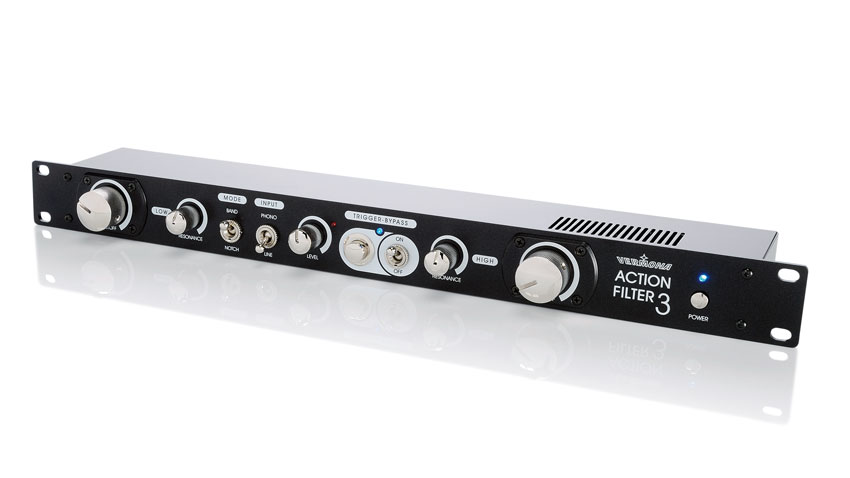MusicRadar Verdict
Does what it says, but is probably most useful in the DJ arena rather than as an essential studio tool.
Pros
- +
Easy to use. Phono pre-amp. Filters sound good.
Cons
- -
No front panel ACF I/II switch. Limited use as a studio tool.
MusicRadar's got your back

Vermona Action Filter 3

Rear panel
Vermona, in various guises, has been in the filter game for many years, and one of the staples of its catalogue has always been some form of rackmount filter unit.
The origins of the Action Filter line date back more than a decade with the arrival of the Vermona DAF-1 Dual Analog Filter. This was ultimately distilled into a live performance filter aimed at DJs - and was even licensed to Stanton in the form of the Stanton DJF-1 Professional Filter.
The Action Filter 3 is a 1u 19-inch rackmount unit which is little more than 6cm deep. The black steel case is very sturdy and this toughness is matched by the metal knobs and switches used throughout - it really feels like it can take a lot of abuse.
There's a built-in switched-mode power supply, which means no external power adaptor (as on earlier units). It can work almost anywhere in the world, as the standard 'kettle lead' connector will accept any AC voltage between 90 and 240V.
"In this age of disappearing vinyl, the Phono input (with grounding post) appears almost quaint from a studio perspective"
Sticking with the back panel, you'll find two sets of inputs - both on RCA/ Phono connectors, that are selected by a front-panel switch. In this age of disappearing vinyl, the Phono input (with grounding post) appears almost quaint from a studio perspective. Of course, this reveals the AF's roots - and key market - that of the DJ.
It's actually quite useful to have a Phono stage racked in the studio - and it certainly worked well with our lowly Technics SL-1210Mk2. The real disappoint from a studio perspective is the complete lack of jack-socket connectivity, let alone any kind of balanced input or output stages.
Action packed
This brings us to the filters - two 24dB/octave stereo analogue filters in series - one low-pass and one high. Each has dedicated resonance and cutoff controls providing immediate hands-on tonal shaping.
Want all the hottest music and gear news, reviews, deals, features and more, direct to your inbox? Sign up here.
A 'Trigger' button at the centre of the rack allows you to 'cut' the filters in and out very fast. Apparently this is now optically-based for maximum durability and sonic transparency, and it was indeed quiet in use - we can see this working well in the hands of a skilled DJ.
Of slight initial confusion for some 'studio-heads' might be the fact that the low-pass is labelled as 'High' - as it filters out the high frequencies - and vice versa. Switching to 'Notch' mode allows you to pull out the middle of the frequency spectrum and leave the top and bottom untouched. The filters remain true to the sound of the second generation Action Filter and, as before, offer an ACF I/ACF II switch on the back panel.
"It would have been nice to have the ability to switch between the two versions from the front panel, although we can see that some might consider this a 'set and forget' parameter."
In broad terms, the ACF I is slightly rougher round the edges than its cleaner ACF II cousin, but also appears to shift the cutoff frequency somewhat and noticeably removes low-end content even when high-pass cutoff is fully counter-clockwise.
It would have been nice to have the ability to switch between the two versions from the front panel, although we can see that some might consider this a 'set and forget' parameter.
Going live
If you need a robust and easy-to-use filter for live use, then the Action Filter 3 should certainly make your shortlist. As a studio tool it's more limited, lacking any form of modulation or external control over its filters - and it's a far cry from Vermona's own Filter Lancet or something like a Moogerfooger Low Pass Filter Pedal.
It could perhaps find a place as a simple vinyl sampling front-end pre-amp, but for most people that probably makes it a bit too niche in its appeal.